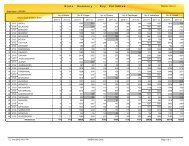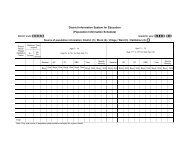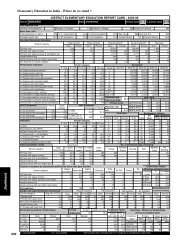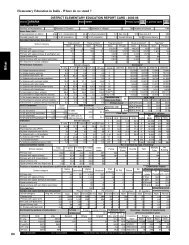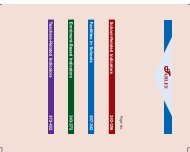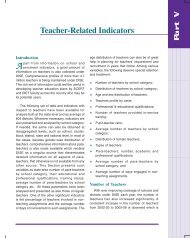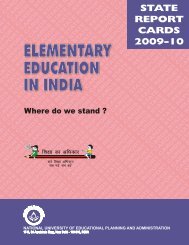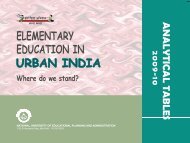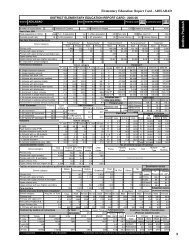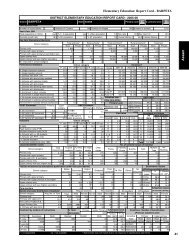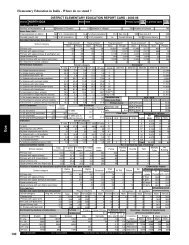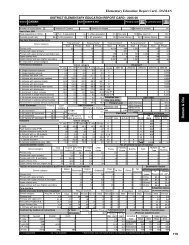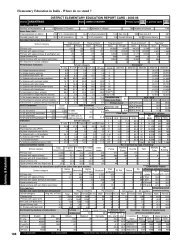Student Flow at Primary Level - DISE
Student Flow at Primary Level - DISE
Student Flow at Primary Level - DISE
- No tags were found...
You also want an ePaper? Increase the reach of your titles
YUMPU automatically turns print PDFs into web optimized ePapers that Google loves.
10 <strong>Student</strong> <strong>Flow</strong> <strong>at</strong> <strong>Primary</strong> <strong>Level</strong>SurveyVariable Type <strong>DISE</strong> ASER-PRATHAM IMRBIntern<strong>at</strong>ionalTeachers PTR and average Percentage of schools Not coverednumber of teachers with no teacher and allby school type teachers available, PTRin schools having GradesI-V and I-VIII based onenrolment and <strong>at</strong>tendanceon day of visitLearners’ Examin<strong>at</strong>ion results Percentage of children Not coveredAttainment in Terminal Grade who can read by GradeIV/V and Grade and %age of childrenVII/VIII: Pass per- who can solve writtencentage and per- numerical sums by Gradecentage childrenobtained 60percentage &above marksBecause of the vari<strong>at</strong>ions in the coverage, all the estim<strong>at</strong>es cannot becompared. Enrolment r<strong>at</strong>io gener<strong>at</strong>ed through <strong>DISE</strong> is based on theenrolment obtained from recognized schools but enrolment in unrecognizedschools is not considered in calcul<strong>at</strong>ing the r<strong>at</strong>io. But in the two householdbasedsurveys, all the children <strong>at</strong>tending schools including the unrecognizedschools, EGS, Madrasas etc. are considered. In the <strong>DISE</strong>, EGS is also notcovered. On the other hand <strong>DISE</strong> collected inform<strong>at</strong>ion from schools loc<strong>at</strong>edboth in the rural and urban areas, but ASER: PRATHAM survey was confinedonly to rural areas. The IMRB Intern<strong>at</strong>ional survey too collected inform<strong>at</strong>ionfrom both the rural and urban areas. Therefore, only estim<strong>at</strong>e of out-ofschoolchildren in the rural areas can be compared. However, in view ofthe vari<strong>at</strong>ion in coverage, the estim<strong>at</strong>e is not available for all the 35St<strong>at</strong>es & UTs of the country. The st<strong>at</strong>es covered vary from survey to survey.The all-India estim<strong>at</strong>es based on the st<strong>at</strong>es covered are not comparablebut they individually present reasonably good amount of inform<strong>at</strong>ion aboutdifferent aspects of UEE. It may be recalled th<strong>at</strong> inform<strong>at</strong>ion under <strong>DISE</strong>is collected as on September 30, 2005 compared to between July andOctober 2005 in the case of IMRB Intern<strong>at</strong>ional and between October andDecember 2005 in case of ASER: PRATHAM survey.While comparing estim<strong>at</strong>es, it may also be noted th<strong>at</strong> Enrolment R<strong>at</strong>iobased on <strong>DISE</strong> d<strong>at</strong>a presents coverage of child popul<strong>at</strong>ion (6-11 years) inprimary classes in schools th<strong>at</strong> reported <strong>DISE</strong> d<strong>at</strong>a; thus children in EGSand unrecognized schools are not considered in calcul<strong>at</strong>ing the r<strong>at</strong>io. On




